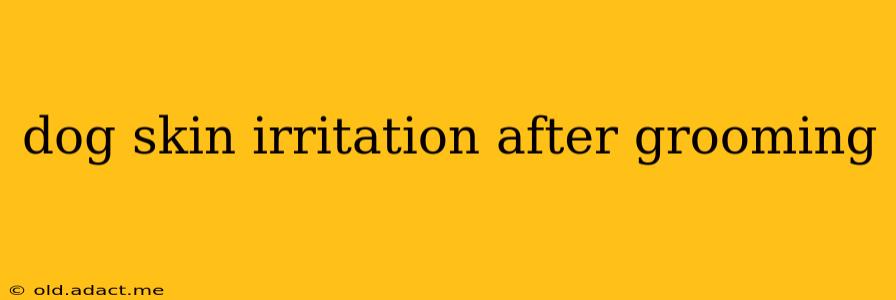Grooming is essential for maintaining a dog's health and hygiene, but sometimes it can lead to unexpected skin irritation. This can range from mild redness to severe itching and inflammation. Understanding the causes of post-grooming skin irritation is crucial for prevention and effective treatment. This comprehensive guide will explore the common culprits and offer solutions to keep your furry friend comfortable and happy.
What Causes Skin Irritation After Grooming?
Several factors can trigger skin irritation after grooming. These can be broadly categorized into:
1. Allergic Reactions:
- Grooming Products: Many shampoos, conditioners, and sprays contain fragrances, dyes, and preservatives that can trigger allergic contact dermatitis in sensitive dogs. These reactions can manifest as redness, itching, swelling, and even secondary infections from scratching. Look for hypoallergenic, fragrance-free products specifically designed for dogs.
- Environmental Allergens: Grooming can inadvertently expose your dog to allergens present in the environment, such as pollen, dust mites, or mold spores. This is especially relevant if grooming takes place outdoors or in a poorly ventilated area.
2. Physical Irritation:
- Sharp Tools: Improper use of clippers, scissors, or brushes can cause nicks, cuts, and abrasions, leading to irritation and potential infection. Always use sharp, well-maintained tools and be gentle during the grooming process.
- Excessive Pulling or Brushing: Aggressive brushing or pulling, especially on matted fur, can damage the skin and cause inflammation. Patience and gentle techniques are key to avoiding this.
- Heat from Dryers: Overuse of high-heat dryers can burn or dry out the skin, making it more susceptible to irritation. Opt for a low-heat setting and maintain a safe distance from the dryer.
3. Underlying Skin Conditions:
- Pre-existing Conditions: Dogs with underlying skin conditions like allergies, eczema, or mange are more prone to irritation after grooming, as the process can exacerbate their symptoms. If your dog experiences frequent skin issues, consult a veterinarian for diagnosis and treatment.
- Infections: Minor cuts or abrasions during grooming can become infected if not properly cleaned and treated. Signs of infection include increased swelling, pus, and excessive pain.
How to Prevent Skin Irritation After Grooming?
Prevention is always better than cure. Here's how you can minimize the risk of your dog experiencing skin irritation after grooming:
- Use Hypoallergenic Products: Choose shampoos, conditioners, and sprays specifically formulated for sensitive skin. Look for products with minimal ingredients and avoid those with strong fragrances or dyes.
- Groom Regularly, but Gently: Regular grooming is important, but avoid over-brushing or pulling. Use gentle strokes and take breaks if your dog shows signs of discomfort.
- Use Sharp, Clean Tools: Regularly clean and sharpen your grooming tools to ensure they are in optimal condition.
- Proper Drying Technique: Use a low-heat setting on your dryer or let your dog air dry to avoid heat-related skin irritation. Thoroughly dry the coat to prevent yeast or bacterial infections from developing in damp areas.
- Observe Your Dog: Pay close attention to your dog's reaction during and after grooming. If you notice any signs of discomfort, stop immediately.
What Should I Do if My Dog Shows Skin Irritation After Grooming?
If your dog exhibits skin irritation after grooming, assess the severity and take the appropriate action:
- Mild Irritation (Redness, Mild Itching): Clean the affected area with a gentle, hypoallergenic cleanser. Apply a soothing oatmeal-based balm or a veterinarian-recommended cream. Monitor closely and contact your vet if the irritation doesn't improve.
- Moderate to Severe Irritation (Significant Swelling, Excessive Itching, Weeping): Contact your veterinarian immediately. They can diagnose the underlying cause and recommend appropriate treatment, which may include antihistamines, corticosteroids, or other medications.
- Signs of Infection: Seek veterinary attention immediately if you see signs of infection, such as pus, increased swelling, or excessive pain.
H2: Is it normal for a dog to have a little bit of redness after grooming?
A little redness immediately after grooming isn't necessarily cause for alarm, especially if it's related to simple friction from brushing or drying. However, any persistent redness, swelling, or itching warrants attention. Always monitor your dog for any changes after grooming.
H2: How can I soothe my dog's irritated skin after grooming?
Soothe irritated skin with a cool compress, an oatmeal-based balm, or a veterinarian-recommended cream or spray. Avoid using human products without consulting your vet.
H2: My dog's skin is irritated after a professional grooming appointment – what should I do?
Contact the groomer and explain the situation. Reputable groomers are usually happy to discuss concerns and help resolve issues. However, if the irritation is severe or doesn't improve, take your dog to your veterinarian for an examination.
H2: What kind of shampoo should I use for my dog's sensitive skin?
Look for shampoos labeled as "hypoallergenic," "for sensitive skin," or "oatmeal-based." Avoid shampoos with strong fragrances, dyes, or harsh chemicals. Your veterinarian can provide recommendations based on your dog's specific needs.
By following these preventative measures and addressing irritation promptly, you can ensure your dog's grooming experience remains a positive one, promoting their overall health and well-being. Remember, early intervention is crucial, so don’t hesitate to consult your veterinarian if you have any concerns.
